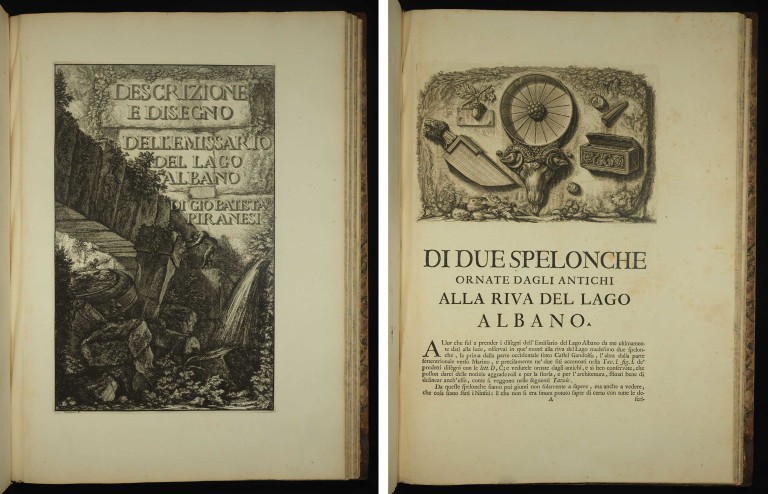Home » HART » Recent Acquisition ~ “Alban Trilogy” by Giovanni Battista Piranesi
Recent Acquisition ~ “Alban Trilogy” by Giovanni Battista Piranesi
Posted by vrcvanderbilt on Wednesday, April 25, 2018 in HART, News, Vanderbilt University, VRC.
 The Jean and Alexander Heard Library has acquired the Alban Trilogy, a beautiful bound volume by Giovanni Battista Piranesi (1720-1778), containing three monographs on ancient monuments in the Alban Hills near Rome: Descrizione e disegno dell’emissario del Lago Albano (Description and Design of the Emissarium of Lake Albano), 1762; Di due spelonche ornate dagli antichi alla riva del Lago Albano (On Two Caves Embellished by the Ancients on the Shore of Lake Albano), 1762; and Antichità d’Albano e di Castel Gandolfo (Antiquities of Albano and of Castel Gandolfo), 1764-69. Each is composed of copper-plate etchings and text pages.
The Jean and Alexander Heard Library has acquired the Alban Trilogy, a beautiful bound volume by Giovanni Battista Piranesi (1720-1778), containing three monographs on ancient monuments in the Alban Hills near Rome: Descrizione e disegno dell’emissario del Lago Albano (Description and Design of the Emissarium of Lake Albano), 1762; Di due spelonche ornate dagli antichi alla riva del Lago Albano (On Two Caves Embellished by the Ancients on the Shore of Lake Albano), 1762; and Antichità d’Albano e di Castel Gandolfo (Antiquities of Albano and of Castel Gandolfo), 1764-69. Each is composed of copper-plate etchings and text pages.
According to ancient legend, the area west of the Alban Lake was where Alba Longa was founded by Ascanius, son of Aeneas; it was perhaps most famous as the birthplace of Romulus and Remus. The crater lake’s sapphire waters and the well-wooded crater edge attracted elite Romans of the late Republic and Empire, and a number of splendid residences were built. The most famous is the villa of the emperor Domitian (r. 81-96 CE), now largely integrated into the gardens of the Apostolic Palace at Castel Gandolfo. When Carlo Rezzonico became Pope Clement XIII (p. 1758-69), he invited Piranesi to the papal residence to work as architect and antiquarian. Piranesi conducted careful studies of the monuments across the area, both on high ground between Castel Gandolfo and Albano Laziale and down by the lakeshore. There, two natural caves had been converted into elaborate reception/dining halls in antiquity, and a monumental intake-building marked the beginning of the emissarium, an 1800-m-long tunnel penetrating the crater’s edge to deliver water to the fields beyond. With rustic masonry walls and complex hydraulic engineering, this monument especially fascinated Piranesi. He published his efforts in the three monographs included in this acquisition.
 The etchings by Piranesi are beautiful and powerful, the work of a true master at the height of his career. The accompanying texts are important documents of Enlightenment scholarship. This acquisition will directly benefit faculty and student research and teaching in the subjects of History of Art and Classical and Mediterranean Studies, especially the history of prints and printmaking, comparative media studies, archaeology and its historiography, and history of science and engineering. This copy of the “trilogy” is the first to come to the American South, and it complements other works by Piranesi in the Vanderbilt University Fine Arts Gallery. It is available for consultation in Special Collections, Vanderbilt University Library and a special exhibition highlighting this acquisition is planned for Commencement week.
The etchings by Piranesi are beautiful and powerful, the work of a true master at the height of his career. The accompanying texts are important documents of Enlightenment scholarship. This acquisition will directly benefit faculty and student research and teaching in the subjects of History of Art and Classical and Mediterranean Studies, especially the history of prints and printmaking, comparative media studies, archaeology and its historiography, and history of science and engineering. This copy of the “trilogy” is the first to come to the American South, and it complements other works by Piranesi in the Vanderbilt University Fine Arts Gallery. It is available for consultation in Special Collections, Vanderbilt University Library and a special exhibition highlighting this acquisition is planned for Commencement week.
The Library Collections Initiative, a program funded by the chancellor and the provost, supports research and scholarship through investments in the permanent and special collections of Vanderbilt’s Jean and Alexander Heard Libraries. Faculty work with librarians to identify collections that enhance the depth and breadth of our research holdings. ~Betsey A. Robinson, associate professor of history of art
Images (above): Antichità d’Albano e di Castel Gandolfo (Antiquities of Albano and of Castel Gandolfo), 1764-69; (below): Descrizione e disegno dell’emissario del Lago Albano (Description and Design of the Emissarium of Lake Albano), 1762; and Di due spelonche ornate dagli antichi alla riva del Lago Albano (On Two Caves Embellished by the Ancients on the Shore of Lake Albano), 1762

©2026 Vanderbilt University ·
Site Development: University Web Communications